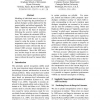1846 search results - page 31 / 370 » On improving application utility prediction |
SBACPAD
2007
IEEE
14 years 4 months ago
2007
IEEE
The necessity of devising novel thread-level speculation (TLS) techniques has become extremely important with the growing acceptance of multi-core architectures by the industry. H...
HPDC
2002
IEEE
14 years 2 months ago
2002
IEEE
Performance models provide significant insight into the performance relationships between an application and the system used for execution. The major obstacle to developing perfor...
MVA
1996
13 years 11 months ago
1996
In this paper we apply a new data driven 3D prediction step for active contour models to car tracking on highways. The so called 3D bounding volume (BV) is a coarse 3D representat...
ACL
2009
13 years 7 months ago
2009
Modeling of individual users is a promising way of improving the performance of spoken dialogue systems deployed for the general public and utilized repeatedly. We define "im...
CDC
2008
IEEE
14 years 4 months ago
2008
IEEE
Abstract— In this paper we present a dual-based decomposition method, called here the proximal center method, to solve distributed model predictive control (MPC) problems for cou...

